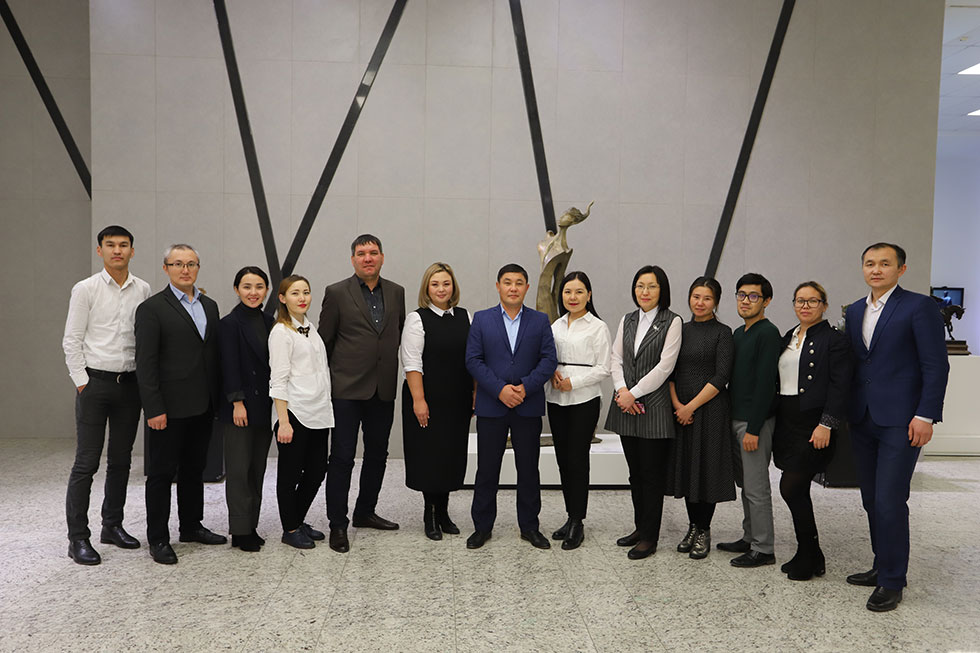
ABOUT US
In the context of the progressive development of Kazakhstan at the present stage as a full-fledged subject of the world community, there is an urgent need to preserve and study, as well as promote scientific knowledge about the national heritage of the Kazakh people, in accordance with the realities and needs of modern society.
One of the important tools for implementing the tasks of preserving cultural heritage is the creation of a state non-profit research institution.
The concept of the Research Institute "Khalyk Kazynasy" was developed in accordance with the Law of the Republic of Kazakhstan "On Culture" dated December 15, 2006, the Law of the Republic of Kazakhstan "On Science" dated February 18, 2011, according to UNESCO documents (UNESCO Convention on the Protection of Cultural and Natural heritage, 1972, International Convention for the Safeguarding of the Intangible Cultural Heritage, 2003) and ICOM on Cultural Diversity and Preservation of Cultural Heritage.
The purpose of the Institute:
Exploring, preservation, reconstruction and popularization of the cultural heritage of the Kazakh people.
The tasks of the Institute:
In order to fulfill the proposed tasks, the Institute carries out the following activities:
Expected results:
Institute structure
The Institute is a structural subdivision of the National Museum of the Republic of Kazakhstan. The Institute employs 23 employees, including one academician of the National Academy of Sciences of the Republic of Kazakhstan, three candidates of historical sciences, one PhD.
The Institute was founded in 2014 and includes the following divisions:
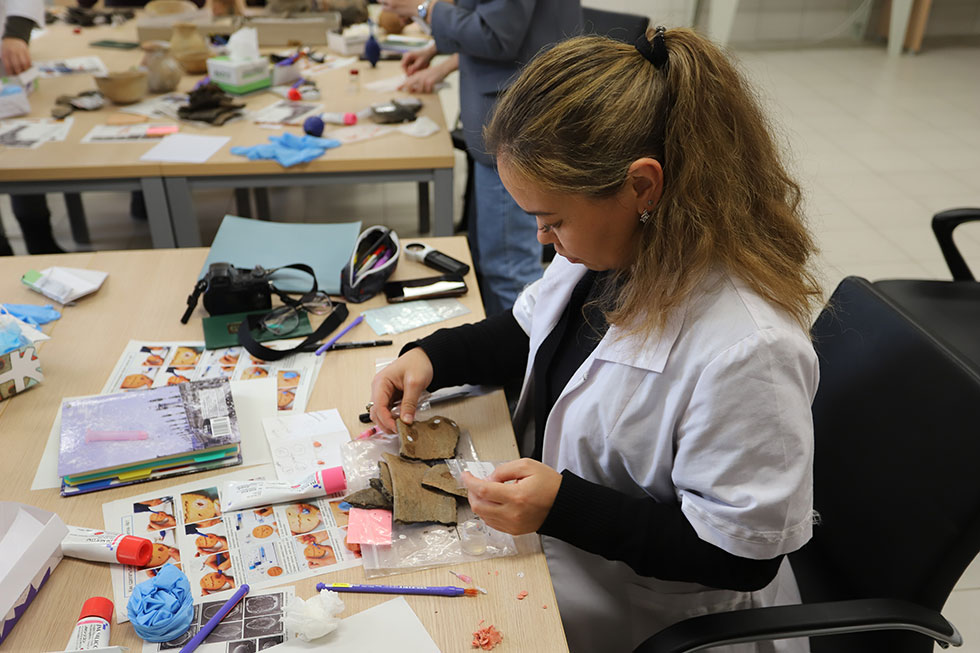
PROJECTS
For five years, the staff of the Institute acted as leaders, co-leaders and executors of 21 scientific and applied scientific projects.
1. "Joint Kazakh-Korean Research" (jointly with the National Institute of Cultural Heritage of the Republic of Korea). Project manager from the Kazakh side - A. Ongaruly (from 2015 to the present day);
2. "Kazakhs of Western Siberia" (jointly with the Omsk branch of the Institute of Archeology and Ethnography of the SB RAS). Project manager from the Kazakh side - A. Musagazhinova (2014–2016);
3. "International Kazakh-Russian archaeological expedition to study monuments of the Stone Age of North-Eastern Kazakhstan" (jointly with the Institute of Archaeology and Ethnography of the SB RAS). Project leader from the Kazakh side - Zh. K. Taimagambetov, executor - T. Mamirov (2015-2016);
4. "PALEOSILKROAD" (jointly with the University of Tubingen, Germany). The project manager from the Kazakh side is Zh.K. Taimagambetov, performer - T. Mamirov (2016);
5. Grant project of the CS MES RK on the theme "Sako-Savromat cultural horizon of the Kazakh steppes: research of the problems of intercultural contacts in the historical diachrony" (jointly with the A.Kh. Margulan Institute of Archeology). Project manager - A. Ongaruly (2015–2017);
6. Grant project of the SC MES RK on the theme “Worldview and religious ideas of the Sako-Massagets of Ustyurt and the Aral Sea region based on the materials of temple complexes (together with the A.Kh. Margulan Institute of Archeology). Project manager - A. Ongaruly (2015–2017);
7. Grant project of the SC MES RK on the topic “The most ancient population of the Aral-Caspian region: migration and evolution of cultures (epochs of stone and paleometal)” (jointly with the A.Kh. Margulan Institute of Archeology). Project manager - T. Mamirov (2015–2017);
8. Grant project of the SC MES RK on the theme "Paleolithic of the South-West Balkhash region" (jointly with the A.Kh. Margulan Institute of Archeology). Co-director of the project - T. Mamirov (2015–2017);
9. Sponsorship project "Early Iron Age burial mounds of the Torgai steppes". Project manager - A. Ongaruly (2016–2017);
10. Project of the MCS RK "Carrying out and forwarding the cultural heritage of Kazakhstan and preparing a report on the implementation of the UNESCO Convention" On the Safeguarding of the Intangible Cultural Heritage "(2017);
11. "Creation of a database and geoinformation mapping of the historical and cultural heritage of Saryarka." Project manager - A. Ongaruly (from 2015 to the present day);
12. "Monuments of Sakas and Syanbi people of the Kazakh Altai" (jointly with the state historical and cultural reserve-museum "Berel"). Project manager - Z. Samashev, main performer - A. Ongaruly (2018);
13. "Creation of a database and geoinformation mapping of the historical and cultural heritage of Aulieata" (2018);
14. "National Kazakh cuisine, as an integral part of the country's tourist brand" (jointly with the Kazakh Academy of Nutrition, JSC NC "Kazakh Tourizm", RPO "Qazaqgeography"). Project manager - A. Musagazhinova (2018–2019);
15. Grant project of the SC MES RK on the topic "Urban culture of the Aral Sea region in the zone of contacts between farmers and pastoralists (I millennium AD)" (jointly with Korkyt-ata KSU). Co-leader of the project - R. Darmenov (2018–2020);
16. Grant project of the KN MES RK on the topic “Ethnocultural ties of the Oghuz Turks with the settled agricultural tribes of the Aral Sea region in the process of the formation of urban culture in the lower reaches of the Syr-Darya (I millennium AD)” (jointly with Korkyt-ata KSU). Co-leader of the project - R. Darmenov (2018–2020);
17. . "Archaeological work on the settlement of Sortobe" (jointly with Korkyt-ata KSU). Co-leader of the project - R. Darmenov (2018–2020);
18. Program-target project of the KN MES RK "Study, preservation and popularization of the cultural heritage of Saryarka". Project manager - A. Ongaruly (2018–2020);
19. "Altai-Tarbagatay: from the Bronze Age to the Early Middle Ages" (jointly with the state historical and cultural reserve-museum "Berel"). Project manager - Z. Samashev, executor - A. Ongaruly (2019);
20. "Development of virtual 3D tours around the monuments of the Mangystau region" (2019);
21. International exhibition project "Procession of the Golden Man in the Museum of the World" (2018–2020).
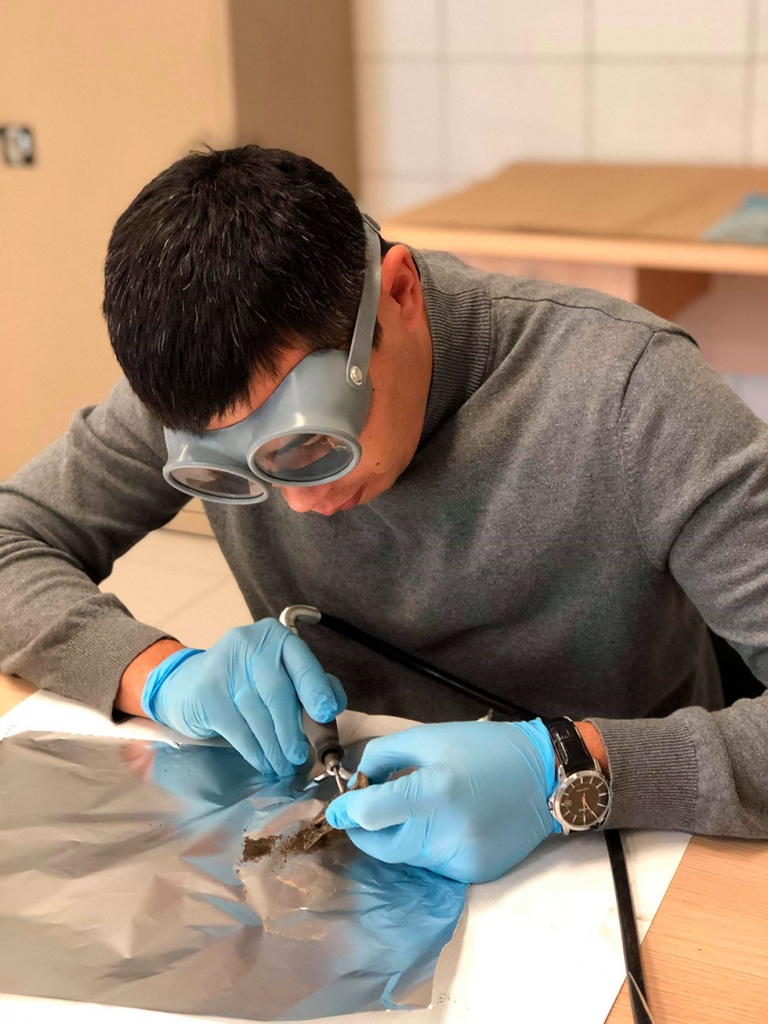
ARCHAEOLOGICAL HERITAGE
The Department of Archaeological Heritage is primarily engaged in archaeological research on the territory of Kazakhstan and neighboring countries.
Since 2015, through the efforts of the Department's staff, 42 archaeological expeditions have been organized and carried out on the territory of Kazakhstan.
The main ones are:
1. Joint Kazakh-Korean expedition. Burial ground Katartobe. Almaty region, Raiymbek and Kegen districts (2015–2019);
2. Joint Kazakh-Russian expedition. Monuments of the Stone Age. East Kazakhstan region (2015–2016);
3. Tortobinsky detachment. Burial and memorial complex Tortoba. Aktobe region, Kobdinsky district (2015–2017);
4. Karkarinsky detachment. Funeral and memorial complex of Karkara. Almaty region, Raiymbek district (2015–2017);
5. Mangystau detachment. Aigirli 2 and Hatem shrines. Mangystau region, Tupkaragan and Munayly districts (2015–2017);
6. Torgai detachment. Burial and memorial complex Saba. Kostanay region, the territory of the city of Arkalyk (2017–2019);
7. Tarbagatai detachment. Cemetery Eleke sazy. East Kazakhstan region, Tarbagatai district (2018–2019);
8. Kyzylorda detachment. Monuments of the Djetyasar culture (Shirkeili Kosasar), the medieval settlements of Zhankent and Kyshkala. Kyzylorda region (2017–2019), etc.
The geography of archaeological research covered almost the entire territory of Kazakhstan from east to west.
Chronological framework of research: from the Stone Age to the early Middle Ages.
As a result of the field work, new materials were obtained on the ancient and medieval history of the Kazakh steppes.
During the period of field archaeological work from 2015 to 2019, the laboratory of "the Khalyk Kazynasy" Institute of the National Museum of the Republic of Kazakhstan received about 10,000 artifacts, and the fund was replenished with paleoanthropological, paleozoological and other new materials.

INTANGIBLE CULTURAL HERITAGE
The department conducts research in the field of study, preservation and popularization of the intangible heritage of the Kazakh people.
One of the most important ways to preserve traditional folk culture is the organization and conduct of ethnographic expeditions. Thanks to them, monuments of both material and spiritual culture are acquired, studied and preserved.
For five years we have organized and conducted 11 ethnographic and musical-folklore expeditions to different regions of Kazakhstan. A website www.ich.kz has been developed for the preservation and popularization of the intangible cultural heritage of the Kazakh people.
Within the framework of the project "Study, preservation and popularization of the cultural heritage of Saryarka" (2018–2019), we carried out field work on the intangible cultural heritage of the Kazakhs of Saryarka and Western Siberia. The collection of materials was carried out by methods of interviews and photography. According to specially developed questionnaires, 300 informants were interviewed, 250 questionnaires were filled out, recipes and technologies for preparing 150 dishes of Kazakh national cuisine in this region were recorded.
On the basis of the signed memorandum with the Omsk branch of the Institute of Archeology and Ethnography of the SB RAS, in 2017-2018, joint expeditions were organized and carried out to study the ethnography of Kazakhs in the border area. As a result of our work, we recorded 25 forgotten dishes of Kazakhs of Western Siberia and Altai Territory. The material has been worked out with 45 informants who are experts in family and household rituals (ceremonies associated with the birth of a child, funeral and memorial ceremony).
The project "National Kazakh cuisine as an integral part of the country's tourism brand" is aimed at the commercialization of scientific research. For two years, recipes for 200 dishes were restored, together with the Kazakh Academy of Nutrition, the food biological value was calculated, new products were introduced (desserts with mare's and goat's milk). The book "Kazaky as: dәstүr men dәm" was published.
One of the important directions of the department is the study of the musical heritage of the Kazakh people. In this direction, in 2017–2019, field studies were carried out on the territory of Almaty, South Kazakhstan (now Turkestan) and Karaganda regions. As a result, 431 pieces of music (in audio / video and photo format) were collected and recorded. Among them - 197 kuis, 83 folk and original songs, 9 jarapazan, 10 sonsu, 70 batas, 20 zhoktau, 16 karaolen, 2 kissa, 2 song-zhyr, etc.
As a result of studying the musical heritage of the Kazakh people, we have prepared and published three books: M. Husayynuly, Қ. Akhmeruly “Altai-Kobda Kazakhtarynyk dombyra zhune sybyzky kuyleri”, “Shakir Abenovtin kuy murasy” and Bolat Sarybaev “Kazaktyk muzykalyk asaptary. Kazakh Musical Instruments ".
In the book of M. Hұsayynuly, Қ. Akhmeruly “Altai-Khobda Kazakhtarynyk dombra zhune sybyzky kuyleri” for the first time were collected, notated and published previously unknown and partially published 321 kyuis traditions of the shertpe Kazakhs of Altai-Kobda. It also provides information on the carriers, performers, who ensured the viability of this rich heritage.
In the book of Bolat Sarybaev “Kazakh musicians” asaptars. Kazakh Musical Instruments ”describes in detail Kazakh wind, string, reed, percussion and self-sounding instruments.
During the period of 2015 and 2019, 6 festivals and 35 master classes on the theme of Kazakh cuisine were held.
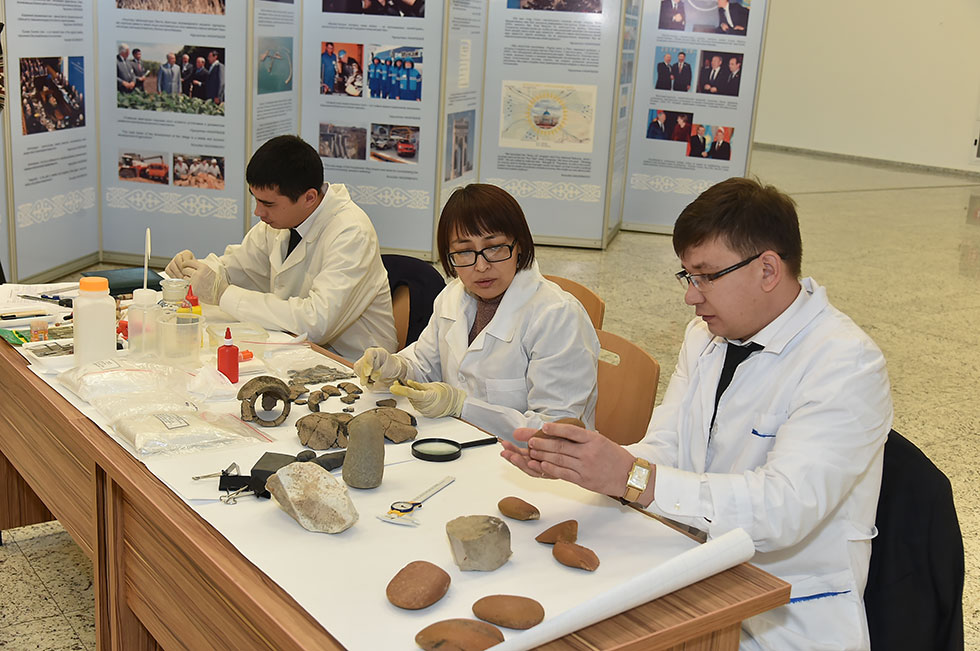
GIS AND 3D MODELING
Since 2015, the Institute has been working on the use of GIS in the formation of databases of historical and cultural objects and electronic mapping of the cultural heritage of Saryarka. In 2015–2018 a geoinformation database of monuments was created and geoinformation mapping of objects of historical and cultural heritage of Enbekshildersky (now Birzhan sal), Zhaksinsky, Sandyktau, Arshali districts of Akmola region was carried out. GIS-mapping of archaeological objects in the Kegen river valley of Almaty region in 2018 was carried out within the framework of the international project "Joint Kazakh-Korean research".
The creation of maps is carried out in the GIS program ArcGISDesktop. The main distinguishing feature of GIS is the use of a coordinate system, often in combination with topology.
GIS mapping methods are also used in the creation of the Code of Monuments of the Akmola region. In 2018–2019, maps of monuments were created for the administrative units of the Ereimentau and Tselinograd districts of the Akmola region. With the help of GIS, a map of the monuments of the Atbasar culture within the Akmola region was also created.
Currently, the creation and use of three-dimensional virtual models of objects (3D-models) is becoming an important part of activities related to state protection, preservation, use and popularization of objects of historical and cultural heritage.
For 2018–2019, 3D models of sacred objects of national and regional significance were scanned and created in Zhambyl (34), Karaganda (37) and Mangistau regions (18). Over the years, the method of photogrammetric 3D scanning has also been used to create 3D models of unique objects in Saryarka (7). They can be viewed on the website https://sketchfab.com/Archaeology.kz.
One of the most important directions of the Institute's activities is toponymic research. The purpose of the work is to collect information about the historical toponyms of Saryarka, their scientific analysis, create a database and introduce them into scientific circulation. In this direction, field research was carried out in Akmola, Karaganda, Kostanay regions and work with the funds of the State Historical Archives of the Omsk Region (Omsk, RF) and the Central State Archives of the Republic of Kazakhstan (Almaty). Based on the analysis of archival documents, a proposal was sent to the Onomastic Commission of the Akmola region to return the historical names to 36 settlements.
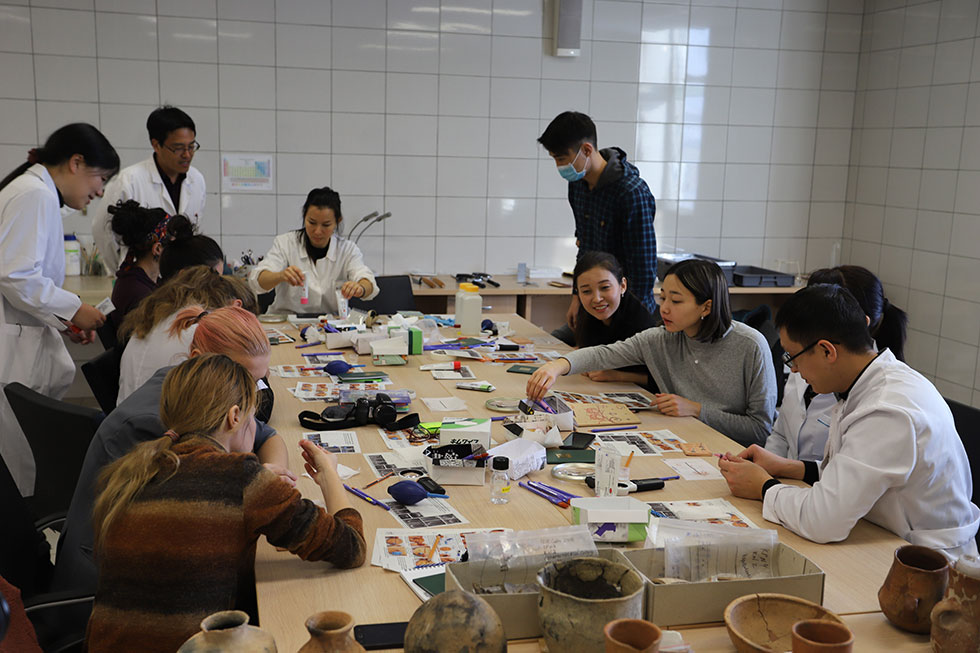
LABORATORY WORKS
A separate subdivision of the Institute is the laboratory of physical anthropology. The laboratory of physical anthropology is headed by the well-known anthropologist, academician of the National Academy of Sciences of the Republic of Kazakhstan O. Ismagulov.
The results obtained under a comprehensive program for studying the modern Kazakh population indicate that the Kazakh people have their own anthropological status in terms of such indicators as somatology, odontology, dermatoglyphics, serology, and craniology. Consequently, the formation of the physical traits of the Kazakh people is rooted in deep antiquity, more than four millennia long.
Under the leadership of the academician, a new exhibition hall is being created in the National Museum of the Republic of Kazakhstan, which will present data on the physical anthropology of the Kazakh people and their ancestors. The exposition is designed to show the ways of the formation and development of the Kazakh people on the ancient Kazakh land for over 40 centuries.
A book by O. Ismagulov and A. Ismagulova “The Origins of the Kazakh People” has been published. At this stage, work is underway to write two books by O. Ismagulov and A. Ismagulova - "Kazakh khalky zhane ata tegi" and "Aiteke-bi (historical and anthropological research)".
Today, 9768 finds obtained as a result of archaeological work throughout Kazakhstan are temporarily stored in the funds of the Institute, which of thsese metal items - 851 items, bone - 13 items, wood - 7 items, stone - 4258 items, whole ceramic vessels - 42 items, ceramic fragments - 4597 items.
One of the most important directions of the laboratory for the primary processing of archaeological material is the study and analysis of ceramics, namely the study of the technique and technology of ancient pottery production. During 2018-2019, the laboratory studied and reconstructed 183 ceramic vessels from settlements and burial grounds from the Eneolithic to the early Iron Age. Experts from the laboratory also carry out primary conservation of archaeological metal. Some 106 items have been processed by the laboratory staff.
PARTNERS
1. National Research Institute for Cultural Heritage of the Republic of Korea
2. National Research Institute for Cultural Properties Nara Nara National Research Institute for Cultural Properties
3. Institute of Archeology and Ethnography of the Siberian Branch of the Russian Academy of Sciences
4. Omsk Branch of the Institute of Archeology and Ethnography of the Siberian Branch of the Russian Academy of Sciences
5. RSCE “Institute of Archeology named after A.H. Margulan" of the Science Committee of the Ministry of Education and Science of the Republic of Kazakhstan
6. LLP "Kazakh Academy of Nutrition"
7. Nazarbayev University
8. KSU "Center for the Protection and Use of Historical and Cultural Heritage" of the Department of Culture, Archives and Documentation of the Akmola Region
9. MSOP "Center for the Protection of Historical and Cultural Heritage" of the Department of Culture, Archives and Documentation of the Karaganda Region
10. Branch of the Institute of Geography in Astana
11. State Historical and Cultural Reserve-Museum "Berel" of the Ministry of Culture and Sports of the Republic of Kazakhstan
12. RSE on PVC "Kyzylorda State University named after Korkyt Ata" of the Ministry of Education and Science of the Republic of Kazakhstan
13. Arkalyk State Pedagogical Institute named after I. Altynsarin of the Ministry of Education and Science of the Republic of Kazakhstan
14. Pavlodar State Pedagogical University of the Ministry of Education and Science of the Republic of Kazakhstan
15. JSC NC "Kazakh Tourizm"
16. RPO "Qazaqgeography"
PUBLICATIONS
For five years we have released 40 books. Some of these 18 monographs, 2 sets of historical and cultural monuments in the districts of Akmola region, 2 yearbooks, 3 collections of scientific articles, 2 joint catalogues, 11 catalogues of temporary exhibitions, one album and one methodological manual.
since 2014
1. Бейсенов А.З., Варфоломеев В.В., Касеналин А.Е. Памятники бегазы-дандыбаевской культуры Центрального Казахстана. – Алматы: «Хикари», 2014. – 191 с.
2. Артюхова О.А., Мамиров Т.Б. Каменный век Сарыарки. – Алматы: «Хикари», 2014. – 295 с.
2015
3. «Кенесары-хан және қолбасшы: мәселелер және ізденістер». – Астана, 2015. – 124 б.
4. Сарыбеков М., Елеуов М., Абдуалы А., Жолдасбаев С., Талеев Д., Серікбаев Е., Ақымбек Е., Есенов С. Ұлы көш жолымен. – Тараз: Тараз университеті, 2015. – 293 б.
2016
5. Ахметжан Қ. Қазақтың отты қаруларының тарихы. «Қазына». 1-шығарылым. – Астана: ҚР Ұлттық музейі, 2016. – 320 б.
6. Ұлттық музей топтамасындағы қазақтың зергерлік өнері. «Қазына». 2-шығарылым. – Ювелирное искусство казахов в коллекции Национального музея. «Казына». Выпуск 2. – Jewelry art of kazakhs in collection of the National museum. “Kazyna”. Volume II. – Астана: ҚР Ұлттық музейі, 2016. – 304 б.
7. Ғасырлар алтыны. Ұлттық музейдің алтын және күміс бұйымдарының топтамасы. «Қазына». 3-шығарылым. – Золото веков. Коллекция предметов из золота и серебра Национального музея. «Казына». Выпуск 3. – Gold of ages. Collections of Gold and Silver of the National museum of Kazakhstan. “Kazyna”. Volume III. – Астана: ҚР Ұлттық музейі, 2016. – 368 б.
8. Самашев З., Цэвээндорж Д., Онгар А., Чотбаев А. Древнетюркский культово-поминальный комплекс Шивээт улаан. – Алматы: Полиграфкомбинат, 2016. – 272 с.
9. Шәкір Әбеновтің күй мұрасы. – Астана, 2016. – 69 б.
10. Саки и савроматы Казахских степей: контакт культур. Сб. статей. – Алматы: Полиграфкомбинат, 2016. – 252 с.
11. Религия и система мировоззрений древних и средневековых номадов Евразии. Сб. статей. – Алматы, 2016. – 152 с.
2017
12. Смағұлов О. Происхождение казахского народа. – Алматы, 2017. – 196 с.
13. Оңғар А. Қазақстанның ежелгі тұрғындарының жерлеу ғұрпы. – Алматы: Ә.Х. Марғұлан ат. Археология институты, 2017. – 252 б.
14. Оңғар А., Ольховский В.С., Астафьев А., Дарменов Д. Древние святилища Устюрта и Восточного Приаралья. – Алматы: Институт археологии им. А.Х. Маргулана, 2017. – 320 с.
15. Елеуов М., Талеев Д., Есенов С. Шу өңірінің ортағасырлық ұзын қорғанды қалалары. – Алматы: Қазақ университеті, 2017. – 113 б.
16. Ұлы дала мұралары. 1-шығарылым. Жылдық ғылыми басылым. – Наследие Великой степи. Выпуск 2. Научный ежегодник. – Астана, 2017. – 252 б.
17. Қазақстанның тарихи-мәдени мұра нысандары: зерттеу, сақтау және пайдалану. Әдістемелік-көмекші құрал – Астана, 2017. – 144 б.
2018
18. Хұсайынұлы М., Ахмерұлы Қ. Алтай-Қобда қазақтарының домбыра және сыбызғы күйлері. «Қазына». 4-шығарылым. – Астана: ҚР Ұлттық музейі, 2018. – 720 б.
19. Қазақстан Республикасының Тарих және мәдениет ескерткіштерінің жинағы. Ақмола облысы. 1-шығарылым. Ерейментау ауданы. – Свод памятников истории и культуры Акмолинской области. Выпуск 1. Ерейментауский район. – Астана: ҚР Ұлттық музейі, 2018. – 256 б.
20. Қазақ даласы әміршілерінің алтыны. Корея мен Қазақстан бірлескен каталог. = Золото властелинов Казахских степей. Совместный каталог Республики Корея и Республики Казахстан. – Тэджон, 2018. – 631 б. – қазақша, орысша
21. 카자흐스탄 초원의 황금문화. Gold of the elite of Kazakh steppes. – Daejeon: National Research Institute of Cultural Heritage, National Museum of the Republic of Kazakhstan, 2018. – p. 443. – korean
22. Әулие атаның қасиетті жерлері. – Астана, 2018. – 216 б.
23. Альбом историко-культурных объектов и мест всеобщего паломничества Казахстана. – Астана: КазНИИК, 2018. – 496 б.
24. Ұлы дала мұрасы: зергерлік өнер жауһарлары. I-том. Ғасырлар қойнауынан. Көрме каталогы. – Наследие Великой степи: шедевры ювелирного искусства. Том I. Из глубин веков. Каталог выставки. – Астана: Национальный музей Республики Казахстан, 2018. – 252 б. – қазақша, орысша.
25. Ұлы дала мұрасы: зергерлік өнер жауһарлары. II-том. Дәстүрлер мен инновациялар. Көрме каталогы. – Heritage of the Great Steppe: masterpieces of jewelry art. Volume II. Tradition and innovation. The exhibition catalogue. – Наследие Великой степи: шедевры ювелирного искусства. Каталог выставки. Том II. Традиции и инновации. – Астана, 2018, – 352 с.
26. Ұлы дала мұрасы: зергерлік өнер жауһарлары. III-том. Ұлы Дала әміршілерінің жауһарлары. Көрме каталогы. – 大草原的遗产:珠宝艺术杰作。第三卷。伟大的草原领主们的艺术杰作。展览目录。– Heritage of the Great Steppe: masterpieces of jewelry art. Volume III. Masterpieces of the lords of the Great Steppe. The exhibition catalogue. – Наследие Великой степи: шедевры ювелирного искусства. Том III. Шедевры Властителей Великой степи. Каталог выставки. – Астана, 2018, – 370 с. – Қазақша, қытайша, ағылшынша, орысша.
27. Ұлы дала мұрасы: зергерлік өнер жауһарлары. IV-том. Көшпелілер өнерінің бейнелер әлемі. Көрме каталогы. – Dziedzictwo wielkiego stepu: arcydzieła sztuki jubilerskiej. Tom IV. Świat sztuki nomadów. Katalog wystawy. – Heritage of the Great Steppe: masterpieces of jewelry art. Volume IV. The world of art images of nomads. The exhibition catalogue. – Наследие Великой степи: шедевры ювелирного искусства. Том IV. Мир образов искусства номадов. Каталог выставки. – Астана, 2018, – 364 б. – Қазақша, полякша, ағылшынша, орысша.
28. Ұлы дала мұрасы: зергерлік өнер жауһарлары. V-том. Өнер тілі. Көрме каталогы. – 대초원의 유산: 금은세공술의 대작. Tom V. 예술의 언어. 안내 책자. – Heritage of the Great Steppe: masterpieces of jewelry art. Volume V. Art language. The exhibition catalogue. – Наследие Великой степи: шедевры ювелирного искусства. Том V. Язык искусства. Каталог выставки. – Астана, 2018. – 476 с. – Қазақша, корейше, ағылшынша, орысша.
2019
29. Болат Сарыбаев. Қазақтың музыкалық аспаптары. «Қазына». 5-шығарылым. – Болат Сарыбаев. Казахские музыкальные инструменты. «Казына». Выпуск 5. Под ред. А. Онгарулы. – Нұр-Сұлтан: ҚР Ұлттық музейі, 2019. – 352 б.
30. Мусагажинова А., Хатран Д., Синявский Ю.А. Қазақы ас: дәстүр мен дәм. Казахская кухня: вкус и традиции. Kazakh kitchen: taste and traditions. – Нур-Султан: РОО "Qazaqgeography", 2019. – 285 б.
31. 카자흐스탄 제티수지역의 고분문화 (Ancient tombs in Zhetisu Kazakhstan). – Daejeon: National Research Institute of Cultural Heritage, National Museum of the Republic of Kazakhstan, 2019. – p. 400. – korean
32. Ұлы Дала мұралары. 2-шығарылым. Жылдық ғылыми басылым. – Наследие Великой степи. Выпуск 2. Научный ежегодник. – Нұр-Сұлтан, 2019. – 256 б.
33. Қазақстан Республикасының Тарих және мәдениет ескерткіштерінің жинағы. Ақмола облысы. 2-шығарылым. Целиноград ауданы. – Свод памятников истории и культуры Акмолинской области. Выпуск 1. Ерейментауский район. – Нұр-Сұлтан, 2019. – 160 б.
34. Сарыарқа және Алтын орда: уақыт пен кеңістік. – Нұр-сұлтан, 2019. – 100 б.
35. Ұлы Дала: тарих пен мәдениет. I-том. Мәдени шығу тек пен сабақтастық. Көрме каталогы. – Великая степь: история и культура. Том I. Истоки и преемственность культур. Каталог выставки. – The Great Steppe: history and culture. Volume I. The origins and continuity of culture. The exhibition catalogue. – Астана, 2019. – 320 б.
36. Ұлы Дала: тарих пен мәдениет. II-том. Жылқы және салт атты. Көрме каталогы. – Великая степь: история и культура. Том II. Конь и всадник. Каталог выставки. – The Great Steppe: history and culture. Volume II. Horse and rider. The exhibition catalogue. Под ред. А. Онгарулы. – Нур-Султан, 2019. – 300 б.
37. Ұлы Дала: тарих пен мәдениет. III-том. Көне түркілер әлемі. Көрме каталогы. – Великая степь: история и культура. Том III. Мир древних тюрков. Каталог выставки. – The Great Steppe: history and culture. Volume III. The world of the ancient turks. The exhibition catalogue. Под ред. А. Онгарулы. – Нур-Султан, 2019. – 454 с.
38. Ұлы Дала: тарих пен мәдениет. IV-том. Ұлы көш: бұйымдар мен идеялардағы ғұндар мен сарматтардың мұралары. Көрме каталогы. – Büyük Bozkır: Tarih ve Kültür. Cilt IV. Büyük göç: ürün ve fıkirlerdeki Hunlar ve Sarmatların mirası. Sergi kataloğu. – The Great Steppe: history and culture. Volume IV. The Great Navigation: heritage of the hunes and sarmates in things and ideas. The exhibition catalogue. – Великая степь: история и культура. Том IV. Великое кочевание: наследие гуннов и сарматов в вещах и идеях. Каталог выставки. Под ред. А. Онгарулы. – Нур-Султан, 2019. – 308 б.
39. Ұлы Дала: тарих пен мәдениет. V-том. Дала сәні: костюм мен тоқыма. Көрме каталогы. – The Great Steppe: history and culture. Volume V. Steppe fashion: suit and textile. The exhibition catalogue. – Великая степь: история и культура. Том V. Степная мода: костюм и текстиль. Каталог выставки. Под ред. А. Онгарулы. – Нур-Султан, 2019. – 360 б.
40. Ұлы Дала: тарих пен мәдениет. VI-том. Ежелгі технологиялар. Көрме каталогы. – The Great Steppe: history and culture. Volume VI. Ancient technologies. The exhibition catalogue. – Великая степь: история и культура. Том VI. Древние технологии. Каталог выставки. Под ред. А. Онгарулы. – Нур-Султан, 2019. – 360 б.